The Moon is Earth’s only natural satellite. It is the second brightest object in the sky after the Sun. It is the only object, other than Earth, to have been stepped on by human beings.
You can clearly see, particularly with binoculars, many dark patches on the Moon’s surface. Ancient astronomers thought these were filled with water, so they are known as mare, after the Latin for ‘sea’. We now know they are huge solidified pools of lava. There is no atmosphere and no oceans on the Moon, but ice left by crashed comets has been found.
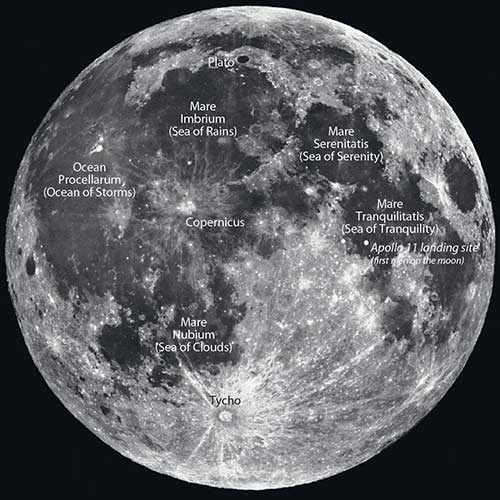
Dominated by large, dark seas of lava, and the prominent ray crater of Tycho in the south, this is the near side of the Moon and the only side ever seen from Earth.
Other parts of the Moon’s surface are very mountainous and there are peaks nearly as high as Mount Everest (the highest mountain on Earth). The Moon is dotted with craters made by meteorite impacts that mostly happened 4 billion years ago. Earth was similarly bombarded at this time, but its atmosphere, rain, wind and water have eroded most of them.
The Moon has been the Earth’s companion and the largest presence in our night sky for several billion years. Its Roman name is Luna and its Greek name is Selene, and its rhythm has been part of our timekeeping for thousands of years. Its synchronous rotation means that although it has been observed for so long we knew nothing about its far side until a probe first photographed it in 1959. Manned Apollo orbits in the late 1960s and early 1970s increased our knowledge of the far side, revealing a densely cratered hemisphere with more highlands and fewer of the darker ‘seas’ than the near side. This indicates a thicker crust where lava could not so easily rise to the surface.
The far side of the Moon was first photographed in 1959, by the Soviet Union probe called Luna 3. This image mosaic was created using images taken by the Lunar Reconnaissance Orbiter Wide Angle Camera between 2009 and 2011.
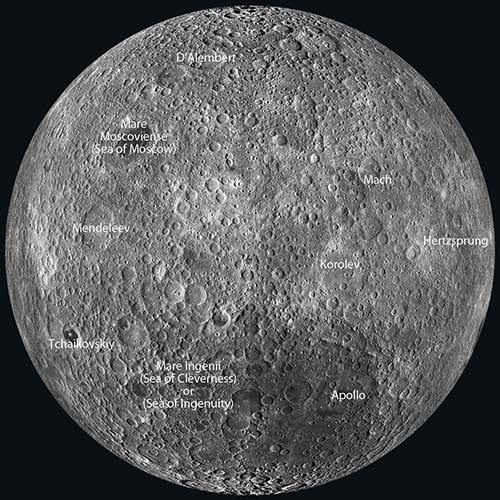 © NASA/Goddard/Arizona State University
© NASA/Goddard/Arizona State University
This side of the Moon has many craters as it is always exposed to impacts, while the near side is shielded by the Earth.
Imagine a planet the size of Mars crashing into the Earth. This is what happened 4.5 billion years ago. The cosmic mash-up generated huge amounts of heat: much of both planets fused together and a huge lump of molten debris was flung out into space. This lump of debris became the Moon. Gravity eventually helped both the Earth and the new Moon pull themselves into spheres.
The Moon changes its appearance to us in a regular monthly pattern, or phases. These phases happen because the Moon orbits the Earth once every 27.3 days. When the Moon passes between the Sun and Earth we can see very little of the sunlight that hits it, causing a new moon phase. Fourteen days later the Moon is on the far side of the Earth from the Sun and we see it completely illuminated. This is a full moon. The lunar phase cycle at 29.5 days is longer than the orbital period of the Moon, this is because during the Moon’s orbit around the Earth the Earth is also moving around the Sun and we have to wait a little longer to see the same phase in the sky.
A blue moon is when there are two full moons in one month, one at the very beginning of the month and one at the end. The last blue moon was 31 March 2018 and the next is 31 October 2020.

The new moon is not visible from Earth.
Although the Moon’s appearance changes, we always see the same side of the Moon. This is because it turns on its axis in exactly the same time it takes to go around the Earth. This is called synchronous rotation. The other side is not ‘dark’, however. Also, although the Moon seems bright to us, its surface is really about as reflective as a lump of coal. Its perceived brightness is due to contrast with the surrounding dark space.
The Moon is 3,476 km in diameter, a quarter the diameter of the Earth. This makes it the largest satellite in the Solar System relative to its planet. Its mass gives it a gravitational pull strong enough to affect our oceans. Tides are highest when at full and new moons. The Moon appears to be same size in the sky as the Sun, allowing for total solar eclipses. This is a coincidence.
Between 1969 and 1972 six Apollo missions landed on the Moon, with twelve astronauts stepping on its surface. You can see from pictures of their missions that the sky on the Moon is always black, even during the day. This is because it has no atmosphere to scatter sunlight. The astronauts wore heavy spacesuits to provide air to breathe and to protect them from the sun’s more intense radiation. But since the Moon’s gravity is one sixth of that on Earth they were still able to leap like gazelles!
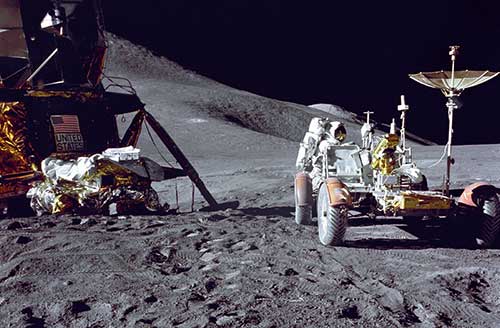 © NASA, Jim Irwin driving the 1971 Apollo 15 lunar rover
© NASA, Jim Irwin driving the 1971 Apollo 15 lunar rover
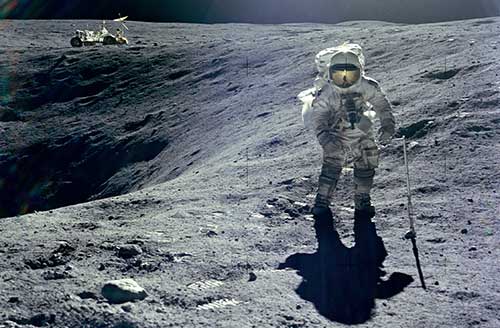 © NASA, Charles Duke collects samples at the rim of Plum crater as part of the 1972 Apollo 16 mission
© NASA, Charles Duke collects samples at the rim of Plum crater as part of the 1972 Apollo 16 mission
Lunar Eclipse
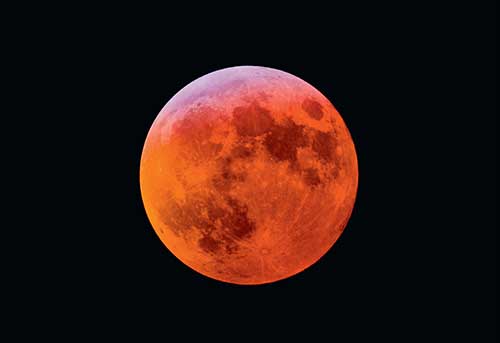 © Primo_Cigler/Shutterstock
© Primo_Cigler/Shutterstock
A lunar eclipse occurs when the Earth passes between the Sun and Moon, and the Earth’s shadow falls on the Moon. A total eclipse makes the Moon appear a reddish colour, as in this image. The next total eclipse of the Moon in the UK is the 16th May 2022.
Solar Eclipse
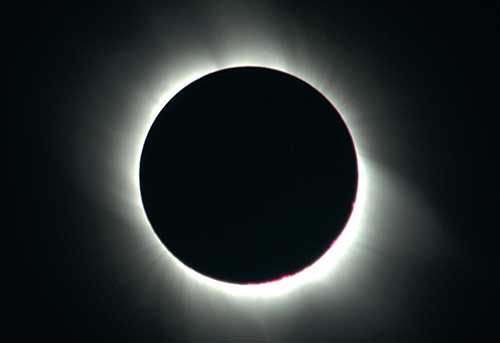 © Vladimir Wrangel/Shutterstock
© Vladimir Wrangel/Shutterstock
A solar eclipse occurs when the Moon passes between the Sun and Earth, and the Moon’s shadow falls on Earth. In this image of a total solar eclipse only the halo of the Sun’s corona is visible around the edge of the Moon
Moon Facts
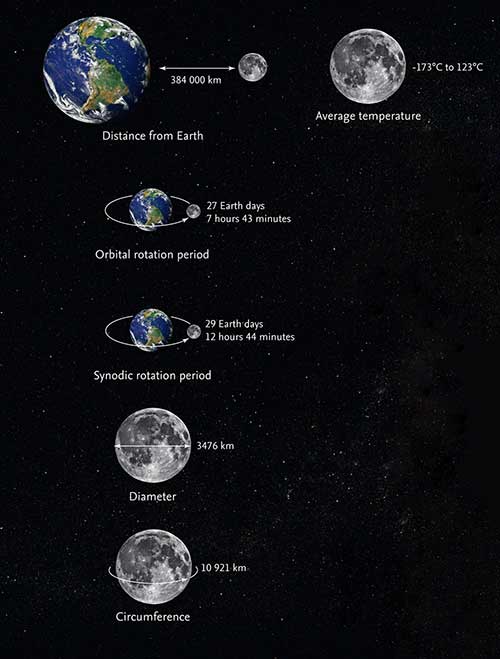
Our latest books, The Moon and Moongazing, are full of even more information and interesting facts, and are a perfect way to celebrate the 50th anniversary of Neil Armstrong’s historic moon landing.



